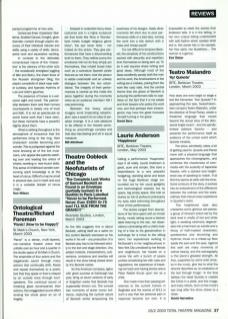How does one even begin to stage a text like Cervantes' Don Quixote? In approaching this task, Swiss-Colombian company Teatro Malandro, under the direction of Omar Porras, create a theatrical language that moves beyond the actual story of the delusional knight errant – and his spindly-limbed sidekick Sancho – and presents the performance itself as evidence of the unreal world which Quixote inhabits.
The show, admittedly, takes a bit of getting used to. Quixote and Panza move with a physical language that approaches the choreographic, and combines the chaoticness of commedia with the austerity of Japanese theatre, with a stylised and heightened way of speaking to match. If at first this seems at odds with the emotional contours of the story, it evolves into an embodiment of the difference between the ordinary and the extraordinary that colours every experience in Quixote's world
This heightened style also unleashes some glorious set-pieces: a group of itinerant actors led by the devil revel in shafts of red and white light; a wedding ceremony degenerates into a hammed-up suicide and a frenzy of half-masked characters; pyrotechnics and drumming and rhythmic thuds on a miked-up floor dazzle the ears and the eyes. Against this swirl are many moments of calmer beauty, and the scenography is this piece's greatest strength. All that, supported by some bold choices in the music, give rise to what the director describes as 'an exaltation of the text through image’. In the final tableau the dead Quixote is cradled like Christ in a pietà, and this image, and many others, burn on the mind's eye long after the show draws to a close.

